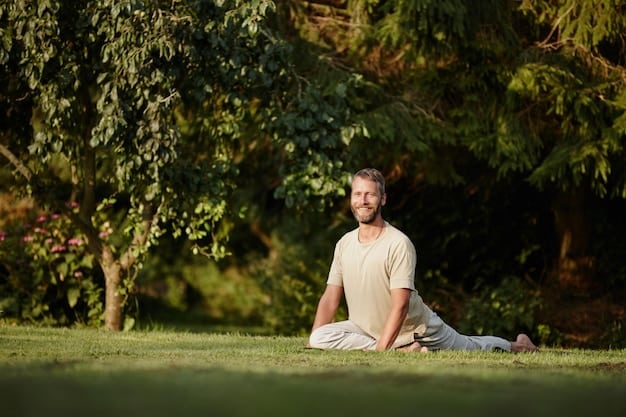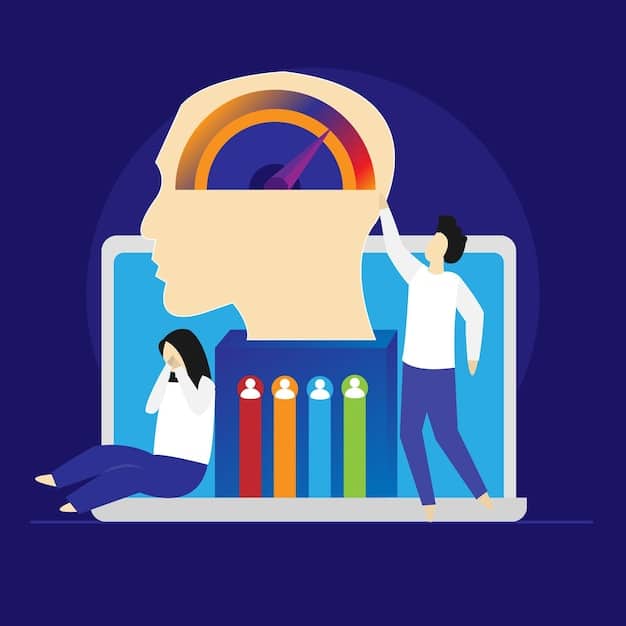How Mindfulness Meditation Can Reduce Anxiety by 25% in US Adults by 2025

Mindfulness meditation has emerged as a potent tool against rising anxiety rates in US adults, with studies indicating its potential to reduce anxiety by as much as 25% by 2025 through consistent practice and integration into daily life.
In a world increasingly grappling with mental health challenges, the search for effective, accessible solutions is more critical than ever. Amidst this quest, a quiet yet profound practice has been gaining significant traction: mindfulness meditation. Evidence suggests that mindfulness meditation can indeed be a powerful ally in this fight, with the ambitious yet achievable goal of contributing to a 25% reduction in anxiety among US adults by 2025. This article delves into the evidence, mechanisms, and practical steps towards realizing this transformative potential.
The rising tide of anxiety in the US
Anxiety disorders are the most common mental illness in the United States, affecting 40 million adults aged 18 and older, or 19.1% of the population, according to the Anxiety & Depression Association of America (ADAA). This widespread prevalence highlights a significant public health concern. The landscape of modern life, characterized by constant connectivity, economic pressures, social media influence, and global uncertainties, often exacerbates these feelings, creating a fertile ground for anxiety to flourish.
The impact of anxiety extends far beyond individual distress. It profoundly affects productivity, relationships, and overall quality of life, placing a substantial burden on healthcare systems and the economy. The search for interventions that are not only effective but also sustainable and scalable is paramount. Traditional treatments, while vital, often require significant resources and may not be accessible to everyone. This widespread need has prompted a re-evaluation of holistic and complementary approaches, of which mindfulness stands out as a promising contender.
Understanding the current anxiety epidemic
The past decade has seen a notable increase in reported anxiety levels across various demographic groups. This trend is not confined to specific age brackets but is observable among adolescents, young adults, and older populations alike. Factors contributing to this rise are multifaceted and include:
- Digital overload: Constant exposure to news cycles and social media can foster a sense of perpetual crisis and comparison.
- Economic uncertainty: Financial instability and job insecurity are significant stressors for many US households.
- Social isolation: Despite increased connectivity, many individuals report feelings of loneliness and detachment.
Acknowledging the complexity of this problem is the first step towards formulating comprehensive solutions. It is not merely about individual coping mechanisms but also about fostering societal resilience and promoting environments that support mental well-being.
The scale of the anxiety epidemic necessitates innovative and accessible interventions. Mindfulness meditation, with its roots in ancient contemplative practices, offers a unique blend of personal agency and profound psychological benefits. Its capacity to be practiced almost anywhere, without specialized equipment, makes it an incredibly democratic tool in the mental health arsenal. This accessibility is key to reaching a broad segment of the US adult population and making a tangible impact on anxiety levels.
What is mindfulness meditation?
Mindfulness meditation is a mental training practice that involves focusing one’s attention on the present moment, observing thoughts, feelings, and bodily sensations without judgment. It is not about emptying the mind, but rather about changing one’s relationship with thoughts and emotions. Rooted in ancient Buddhist traditions, mindfulness has been adapted for modern therapeutic and well-being contexts, gaining scientific validation for its efficacy in improving mental health.
The core principle of mindfulness is awareness—a gentle, sustained attention to what is happening right now, whether externally or internally. This practice cultivates a deeper understanding of one’s own mind and a greater capacity to navigate life’s challenges with composure. It teaches individuals to step back from the incessant chatter of the mind, observing thoughts as transient events rather than absolute truths. This shift in perspective is foundational to its anxiety-reducing power.
Core principles of mindfulness practice
While mindfulness can be practiced in various forms, several core principles underpin its effectiveness:
- Present moment awareness: Directing attention to the here and now, noticing sensory experiences, thoughts, and emotions as they arise.
- Non-judgmental observation: Acknowledging experiences without labeling them as “good” or “bad,” fostering acceptance.
- Patience and persistence: Understanding that mindfulness is a practice that unfolds over time, requiring consistent effort.
These principles are not mere theoretical constructs but practical guides for engaging with one’s inner experience. By integrating them into daily life, individuals can develop a more stable and resilient mind, less susceptible to the cyclical patterns of anxious thought.
Engaging with mindfulness helps to create a space between a stimulus and a response. This pause allows for a conscious choice in how one reacts, rather than being swept away by automatic, often anxious, reactions. This self-awareness is a powerful antidote to the reactive patterns often seen in anxiety disorders, offering a path towards greater emotional regulation and peace of mind.
The science behind mindfulness and anxiety reduction
The scientific community has increasingly turned its attention to mindfulness, producing a wealth of research that explains its mechanisms for reducing anxiety. Neuroimaging studies, randomized controlled trials, and meta-analyses consistently demonstrate that regular mindfulness practice leads to measurable changes in brain structure and function, particularly in regions associated with emotion regulation, self-awareness, and stress response.
Mindfulness meditation’s ability to modulate the amygdala, the brain’s “fight or flight” center, is a key finding. Studies have shown that practice can reduce amygdala activity and promote stronger connections between the amygdala and the prefrontal cortex, the area responsible for higher-order thinking and emotional control. This neuronal rewiring essentially reduces the brain’s reactivity to stressors and enhances its capacity for thoughtful, regulated responses.
Neuroplasticity and brain changes
One of the most compelling scientific explanations for mindfulness’s efficacy lies in its impact on neuroplasticity—the brain’s ability to reorganize itself by forming new neural connections. Consistent meditation practices can:
- Increase grey matter density: Particularly in areas related to learning, memory, emotion regulation, and perspective-taking.
- Reduce activity in the Default Mode Network: This network is often overactive in anxiety, linked to self-referential thought and rumination.
- Enhance functional connectivity: Strengthening connections between brain regions involved in attention and emotional control.
These physiological changes underpin the subjective experience of reduced anxiety, offering a robust scientific basis for the practice. It’s not just about feeling calmer; it’s about fundamentally altering the brain’s architecture to support greater mental well-being.
Furthermore, mindfulness enhances vagal tone, which is a measure of the activity of the vagus nerve, a critical component of the parasympathetic nervous system. A higher vagal tone correlates with better emotional regulation and resilience to stress. By calming the nervous system, mindfulness directly counteracts the physiological manifestations of anxiety, such as increased heart rate, shallow breathing, and muscle tension, paving the way for a more relaxed and centered state of being.
Mindfulness-based interventions: evidence-based approaches

The increasing body of evidence has led to the development of structured mindfulness-based interventions (MBIs) that are formally recognized for their therapeutic benefits. Programs like Mindfulness-Based Stress Reduction (MBSR) and Mindfulness-Based Cognitive Therapy (MBCT) have become gold standards, demonstrating significant success in clinical settings for anxiety, depression, and chronic pain. These programs provide a systematic approach to cultivating mindfulness skills, often over an 8-week period, through guided meditations, mindful movement, and group discussions.
MBSR, developed by Jon Kabat-Zinn, teaches participants to integrate mindfulness into their daily lives, offering tools for managing stress, pain, and illness. MBCT, on the other hand, specifically adapts mindfulness practices to prevent relapse in individuals with recurrent depression, but its principles are also highly applicable to managing anxiety, by helping individuals observe negative thoughts without identifying with them.
Key MBI programs and their impact
Several well-established MBIs offer structured pathways to anxiety reduction:
- Mindfulness-Based Stress Reduction (MBSR): An 8-week course focusing on present-moment awareness, body scan, and gentle yoga to reduce stress and anxiety.
- Mindfulness-Based Cognitive Therapy (MBCT): Combines cognitive behavioral therapy with mindfulness practices to help individuals disengage from unhelpful thought patterns.
- Acceptance and Commitment Therapy (ACT): While not solely an MBI, ACT heavily incorporates mindfulness principles to help individuals accept difficult thoughts and feelings while committing to values-driven actions.
These structured programs provide a framework for individuals to learn and integrate mindfulness into their lives, offering a supportive environment and expert guidance. The curriculum-based nature of these interventions ensures that participants receive comprehensive training, from basic techniques to the deeper philosophical underpinnings of mindfulness, empowering them to sustain their practice independently.
The success of these evidence-based interventions underscores the potential of mindfulness to be systematically applied as a therapeutic tool. By making these programs more accessible through online platforms, community centers, and healthcare providers, the ambitious goal of reducing anxiety by 25% by 2025 becomes increasingly feasible. The scalability of these approaches means that a significant portion of the US adult population can benefit from proven strategies to manage anxiety effectively.
Practical steps for integrating mindfulness into daily life
For mindfulness meditation to achieve a widespread impact on anxiety levels, it must transition from being a niche practice to a mainstream tool accessible to everyone. Integrating mindfulness into daily life doesn’t necessarily mean dedicating hours to formal meditation sessions; it can be achieved through micro-practices and conscious shifts in attention throughout the day. The key is consistency and finding what resonates with individual lifestyles.
Beginning with short, formal meditation sessions—even just 5-10 minutes daily—can lay a strong foundation. There are numerous free and paid apps available, such as Calm, Headspace, and Insight Timer, that offer guided meditations suitable for beginners. These platforms make it incredibly easy to start a practice and track progress, providing the necessary support and structure for those new to mindfulness.
Simple mindfulness practices for busy adults
Even the busiest American adults can weave mindfulness into their routines:
- Mindful breathing: Take a few deep, conscious breaths at various points in the day, focusing solely on the sensation of air entering and leaving the body.
- Mindful eating: Pay full attention to the taste, texture, and aroma of food during one meal a day, reducing distractions.
- Mindful walking: Notice the sensation of your feet on the ground, the movement of your body, and the sights and sounds around you during a short walk.
These small acts of intentional awareness accumulate over time, strengthening the “mindfulness muscle” and gradually reducing reactivity to stressors. The goal is not perfection, but consistent engagement with the present moment, fostering a continuous sense of calm and clarity.
Moreover, integrating mindfulness doesn’t stop at formal practice. It extends to cultivating a mindful attitude in all activities. This means approaching tasks with presence, listening attentively in conversations, and responding thoughtfully rather than reacting impulsively. This pervasive application of mindfulness helps to rewire daily habits and thought patterns, making it a profoundly transformative practice for anxiety management.
Addressing barriers to adoption and ensuring equitable access
While the potential of mindfulness to reduce anxiety is clear, achieving a 25% reduction by 2025 requires addressing significant barriers to its widespread adoption and ensuring equitable access across all demographics in the US. These barriers include misconceptions about mindfulness, lack of awareness, financial constraints, and cultural or systemic biases that might hinder participation.
One common misconception is that mindfulness is a religious practice, which can deter individuals from secular backgrounds. Clarifying that mindfulness, in the context of anxiety reduction, is a secular mental training technique is crucial. Another barrier is the perception that mindfulness requires significant time commitments, which can be daunting for busy individuals. Emphasizing the effectiveness of short, consistent practices can help overcome this.
Strategies for overcoming barriers
- Public awareness campaigns: Educating the public about the secular nature and proven benefits of mindfulness through accessible information.
- Affordable and free resources: Expanding access to guided meditations, online courses, and community-based programs that are low-cost or free.
- Integration into healthcare: Encouraging healthcare providers to recommend and, where appropriate, prescribe mindfulness as a complementary therapy.
- Workplace and school programs: Implementing mindfulness programs in workplaces and educational institutions to foster well-being from an early age.
Addressing these challenges requires a concerted effort from government agencies, healthcare providers, educational institutions, and community organizations. Promoting mindfulness requires more than just offering classes; it involves creating an environment where the practice is understood, valued, and easily accessible to everyone, regardless of their socioeconomic status or cultural background.
Crucially, tailored approaches are needed to ensure that mindfulness resonates with diverse cultural groups. This involves cultural sensitivity in teaching, using inclusive language, and acknowledging different life experiences. By actively working to dismantle these barriers, the vision of a significant reduction in anxiety through mindfulness becomes a genuinely inclusive and attainable goal for all US adults.
Future outlook: potential for a 25% reduction by 2025
The ambitious target of a 25% reduction in anxiety among US adults by 2025, facilitated by mindfulness meditation, is within reach. This future outlook is predicated on several converging factors: the growing scientific validation of mindfulness, increased public awareness, the proliferation of accessible digital tools, and a societal shift towards prioritizing mental well-being. The momentum behind mindfulness is building, pointing towards a transformative period for public health.
Achieving this goal requires continued investment in research to refine practices and identify new applications, robust public health initiatives to promote mindfulness broadly, and systemic changes that integrate mindfulness into healthcare, education, and workplace environments. It is a shared responsibility, where individual commitment meets collective action to foster a more resilient and mentally healthy nation.

Key drivers for achieving the 25% target
Several factors will be instrumental in reaching this significant milestone:
- Technological accessibility: Widespread use of apps and online platforms makes mindfulness guidance available to millions.
- Healthcare integration: As more healthcare systems recognize and recommend mindfulness, its adoption will accelerate.
- Corporate wellness programs: Companies investing in employee well-being through mindfulness initiatives can have a substantial impact.
- Educational curricula: Introducing mindfulness in schools and universities can instill resilience from a young age.
The cumulative effect of these drivers can create a pervasive culture of mindfulness, normalizing its practice and making it a standard component of self-care and mental health maintenance. The shift from reactive treatment of anxiety to proactive prevention and management through mindfulness is a paradigm strong enough to drive the desired outcome.
The journey to a 25% reduction in anxiety is not solely about mindfulness but about fostering a more mindful society that values mental health as much as physical health. Mindfulness meditation serves as a powerful catalyst in this evolution, empowering individuals with the tools to navigate life’s complexities with greater ease and presence. The collective embrace of this practice holds the promise of a calmer, more resilient United States, where the burden of anxiety is significantly lessened, leading to a healthier and happier population.
| Key Point | Brief Description |
|---|---|
| 📊 Anxiety Prevalence | Anxiety affects nearly 20% of US adults, highlighting a critical public health issue. |
| 🧘♀️ Mindfulness Basics | Focuses on present moment awareness, non-judgmental observation, and consistent practice. |
| 🧠 Scientific Basis | Neuroimaging shows mindfulness changes brain structure and function, reducing amygdala activity. |
| 🎯 25% Goal by 2025 | Achievable through increased awareness, accessibility, and integration into daily life. |
Frequently asked questions about mindfulness and anxiety
▼
Studies suggest that even 10-20 minutes of daily mindfulness meditation can significantly reduce anxiety symptoms. Consistency is more important than duration, meaning a short, regular practice is more beneficial than sporadic long sessions. Beginners can start with 5 minutes and gradually increase their time as they become more comfortable.
▼
Mindfulness meditation is a powerful complementary therapy for anxiety, but it should not replace traditional treatments like medication or psychotherapy without consulting a healthcare professional. It works best as an adjunct, enhancing the effectiveness of other treatments and providing tools for self-management, rather than a standalone cure for severe cases.
▼
While generally safe and beneficial, individuals with severe anxiety or other mental health conditions should approach mindfulness under the guidance of a qualified therapist or mindfulness instructor. In some rare cases, intense meditation can exacerbate symptoms if not properly managed. A personalized approach ensures safety and maximizes benefits.
▼
The timeline for results varies greatly among individuals. Some may experience subtle shifts in perspective and calm within weeks, while others might notice significant reductions in anxiety after several months of consistent practice. Long-term benefits typically accrue with sustained effort, as the brain gradually adapts to new patterns of attention and emotional response.
▼
For anxiety, practices focusing on breath awareness, body scans, and mindful movement (like gentle yoga or walking meditation) are often recommended. Mindfulness-Based Stress Reduction (MBSR) and Mindfulness-Based Cognitive Therapy (MBCT) are structured programs with strong evidence for anxiety reduction due to their comprehensive, guided approach.
Conclusion
The journey towards a significant reduction in anxiety among US adults is a challenging yet profoundly important endeavor. As we’ve explored, mindfulness meditation stands as a scientifically validated and highly accessible tool capable of contributing to a 25% reduction in anxiety by 2025. By fostering present-moment awareness, cultivating non-judgmental observation, and integrating these practices into daily life, individuals can fundamentally alter their relationship with anxious thoughts and emotions. The collective efforts to increase awareness, enhance accessibility, and integrate mindfulness into broader societal structures will be pivotal in realizing this ambitious yet attainable goal, paving the way for a more resilient and mentally healthier future for all.





